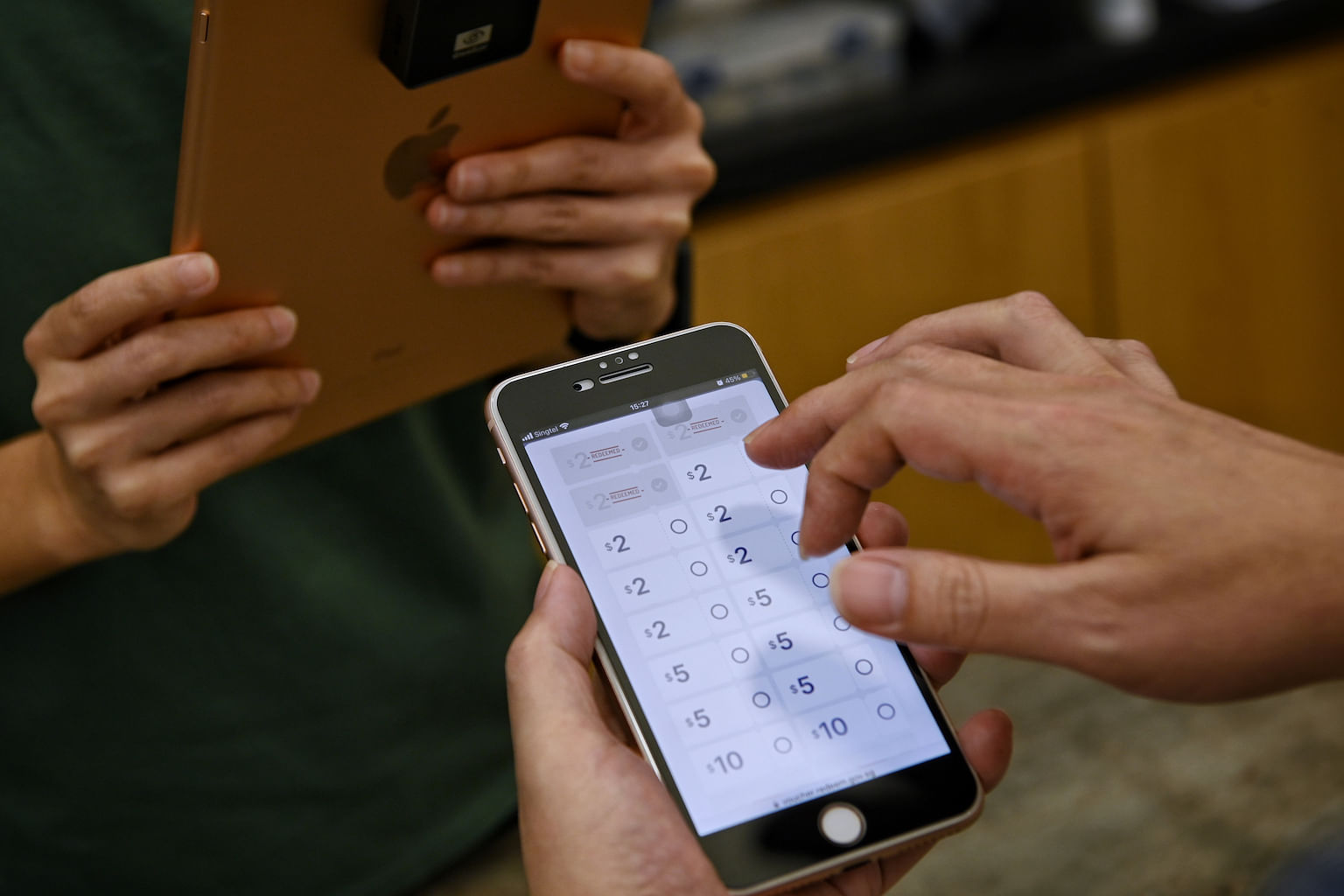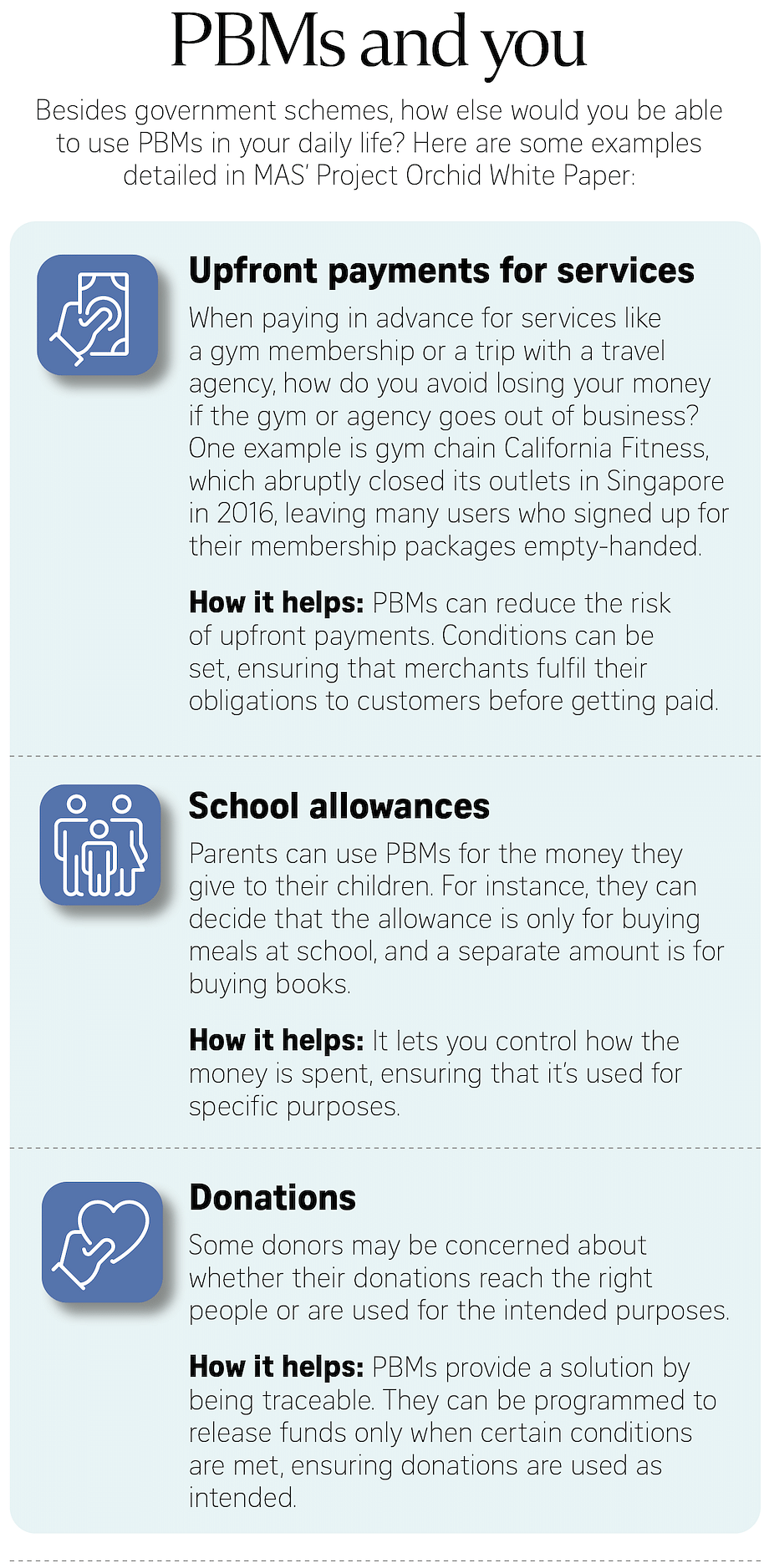BRANDED CONTENT
What you should know about how tokenised digital money helps with safer transactions
Trials are underway to explore the use cases of a digital Singdollar, with a focus on purpose-bound money

One aspect of purpose-bound money is the ability to be programmed for a specific use, such as the Community Development Council (CDC) vouchers.
ST PHOTO: KUA CHEE SIONG
Bill Ng, Content STudio
Follow topic:
Like most Singaporeans, Mr Leslie Koh, 50, welcomed the $300 worth of Community Development Council (CDC) vouchers he received.
He was one of over 1.1 million, or 90 per cent, of Singaporean households who had claimed the third tranche of the vouchers within a month of its launch in January.
The vouchers were part of the Government’s measures to support Singaporeans with cost-of-living concerns. Of the $300, half could be used at participating hawker stalls and heartland merchants’ stores, and the other half at participating supermarkets.
Residents claim the vouchers at go.gov.sg/cdcv. They will receive a link on their verified mobile numbers, where vouchers in fixed denominations of $2, $5 and $10 can be accessed.
To use them, you select the amount, get a QR code, and show it to participating merchants to scan and complete the transaction. The current tranche of vouchers will be valid until Dec 31, and can be claimed any time until then.
“My wife and I found the CDC vouchers convenient and easy to use,” says Mr Koh, an editor at a Christian organisation. “We redeemed most of it at the neighbourhood hawker centre, provision shop and barber.”
So it seemed easy to use. But was it as easy for merchants to accept? Not quite.
The Problem
An AsiaOne report last year revealed that the scheme faced teething issues shortly after it was first launched to all Singaporean households in December 2021.
Some older hawkers were unfamiliar with accepting digital payments and tried to avoid accepting CDC vouchers. Others were short-handed and found it quicker to accept cash. Some hawkers shared that they were duped by consumers who used fake QR codes that did not result in any payment being made.
For voucher schemes like CDC, merchants must also sign separate contracts before joining a new phase of the campaign – even if they had participated in previous ones, notes the Monetary Authority of Singapore (MAS) in its Project Orchid White Paper released last November.
Project Orchid, launched by MAS in 2021, seeks to explore and experiment with the infrastructure needed to implement a digital Singdollar.
Money glossary
Retail Central Bank Digital Currency (CBDC): Digital equivalent of today's notes and coins, issued by a central bank. It exists only in electronic form. In Singapore, it is known as a digital Singapore dollar (Singdollar).
Wholesale CBDC: Digital currency that is confined to interbank systems and does not enter the public space, used only by financial institutions.
Fiat currency: The money that we know and use every day, declared legal tender by a government. It can exist in digital or physical form.
Purpose-bound money: A protocol that sets the conditions upon which an underlying tokenised digital currency can be used.
Tokenisation: The process of converting an asset into a digital token on a blockchain, or digital ledger.
The voucher claiming process also requires all parties – such as the merchants, voucher issuer and bank – to ensure accurate cash flow. Any discrepancies could lead to a “long and costly dispute resolution process”, notes the MAS.
Nevertheless, interest among merchants has grown. The number of participating merchants increased from about 10,000 in 2021, to over 22,000 this year.
But is there a better way to administer such schemes?
The Possible Solution
Purpose-bound money (PBM) could potentially address these issues, says Ms Janet Young, managing director and head of Group Channels and Digitalisation at UOB.
PBM refers to a protocol that sets the conditions upon which an underlying tokenised digital currency can be used.
It controls how the money is spent by “wrapping” rules or conditions around it. These rules can limit spending to specific merchants or particular goods or services.
For example, the Government can use PBM to issue vouchers such as those by the CDCs, which can only be used at participating merchants, and cannot be used beyond the expiry date. If these conditions are met, the digital money is “unwrapped” and released instantly to the merchant during the transaction.
“PBMs, allocated for specific uses or goals, offer several benefits,” says Ms Young. “It promotes financial discipline, ensures funds are directed toward intended objectives, reduces the risk of misallocation, and addresses inefficiencies of the current voucher schemes.”
Intergovernmental blockchain expert Anndy Lian points out that PBMs can enhance payment security and transparency by ensuring that the underlying digital money is used only by the intended person, and for the specific reason spelt out in the PBM.
“PBMs can be used for anti-money laundering, counter-terrorism financing, or tax compliance purposes, where the underlying digital money is traceable and reportable,” Mr Lian explains.
To UOB, PBM is “an important element in the future of digital money as it enables money to be directed towards a specific purpose, without requiring the money itself to be programmed”, says Ms Young.
“As we uncover the potential of PBMs, we open doors to a future of digital money that can direct allocations, driving opportunities for innovation, value creation and efficiency.”

The Potential
MAS’ Project Orchid is exploring the use of PBMs, and various trials have been initiated with banks and the private sector on the applications of PBMs and a digital Singdollar. To support MAS’ efforts, UOB has run three pilot trials so far.
Last year, UOB partnered with SkillsFuture Singapore to explore how the disbursement of SkillsFuture credits for courses by overseas training providers could be enhanced, using a digital Singdollar issued by the bank. The pilot is expected to be completed by the end of the year.
More on the Future of Finance
- AI-powered returns: Can AI do the heavy lifting for you when it comes to investing your hard-earned money? Not quite yet, as a personalised approach is still preferable, says experts.
- More digital, more personal: They way we spend, save and invest is now mostly digital. Besides efficiency and convenience, how will our relationship with money evolve?
- Easier ways to pay on your holiday: Is there still a need to carry cash overseas? How multi-currency digital platforms provide travellers with ease, security and benefits.
At the Formula One festivities in September, UOB worked with Grab and fintech firm Fazz to launch the Singapore Pitstop Pack. Participants could use PBM-based commercial vouchers to make purchases. The vouchers can be used until the end of the year at over 200 participating merchants islandwide, and are available to locals and tourists.
Last month, at the Singapore Fintech Festival, UOB and OCBC ran a trial on the fungibility of a digital Singdollar and interbank settlement using a simulated wholesale CBDC. As part of the trial, participants could request PBM from one bank, and use it to claim a piece of merchandise from the other.
Ms Young says: “The successful completion of the last two pilots represents a significant stride in Singapore’s larger ambition to work towards a truly seamless financial ecosystem with domestic and cross-border applications.”
The Future of Finance series explores how digital solutions and insights can empower individuals and businesses in a rapidly changing world, to create a more sustainable future.
This is the seventh of a 12-part series in partnership with


